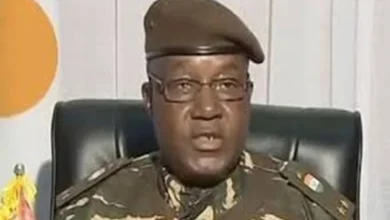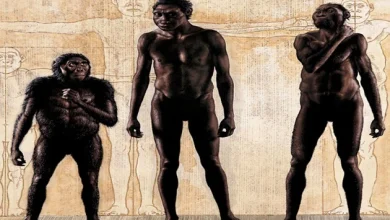African tribal dance: styles and meaning
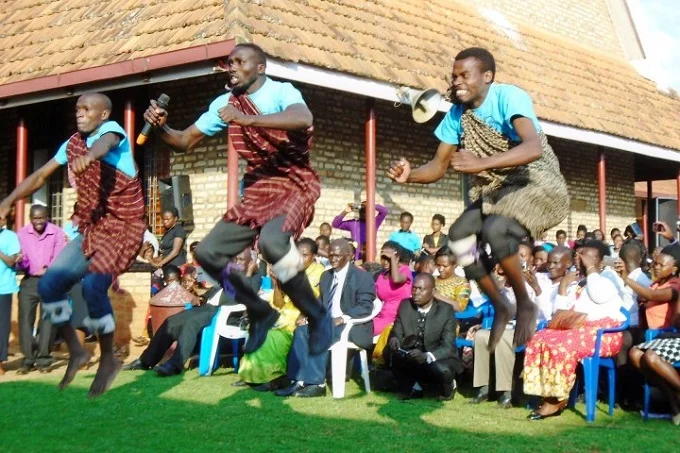
African tribal dances originated from the earliest groups of people found on the vast continent, and it is still used today in the form of dance, both modern and traditional. Dance is the oldest linguistic form of humanity. Understanding its message is accessible to everyone. African dance is no exception.
African tribal dance is a distinctive phenomenon, a folk culture embodied in the movements, musical rhythms, rich in emotion, and incorporating centuries-old customs. There are many varieties, geographic differences, thematic and gender divisions, so the definition of “African dance” unites all the dances of the peoples inhabiting the continent. We will talk in general about the phenomenon and a few specific dance traditions.
Dance has always played an essential role in the life of an African tribe – through dance, information was passed from generation to generation.
First of all, the performance differs in themes: the dance of warriors and hunters, harvest and love, ritual dances – initiation ceremonies, invoking spirits, and healing dances. What is important for all is the expressiveness and sincere passion of the dancer for the process.
The main thing in African dancing is, of course, the rhythm. And rhythm is directly related to the events of life: birth, the period of maturity, marriage, offspring, old age, leaving. In African culture, death is the transition to the other side, from Sasa to Zamani. One leaves the temporary shelter, from the everyday and events of earthly life – back to the eternal, the wise, the sacred.
Components of African tribal dance
Traditional African dances can still be found in the heart of African villages, performed at celebrations or as a pastime. Those who are fortunate enough to travel or on vacation or as part of a humanitarian organization can witness these dances first-hand and are often even invited to participate in the dance movement.
Although tribal dances vary with every culture across the continent, several components are the same everywhere. First of all, the tribal dance is very lively. Very often with their energetic music, and accompanied by a lot of singing, clapping and shouting.
Further, the costumes are often complex, sometimes representing specific regional or religious beliefs of that particular tribe. Decorations made from natural materials used for costumes add theatricality to the dance elements.
The steps themselves are often simple and rhythmic, with twists and turns. Although the entire choreography is usually fairly basic and repetitive, it is extremely enjoyable for both sides of the dancers and the audience, resonating with a unique spirit of joy and brightness. The cultural dances of Africa are thus a real treat!
While deep in the heart of Africa, there is still a place for authentic dance styles, African tribal dances have developed in other forms around the world, including those inspired by some American groups.
Meaning of African tribal dances
The farewell ceremony among the indigenous peoples of Africa is exuberant and necessarily accompanied by songs and dances. It is believed that in this way, people help the departed.
The dances are symbolic and convey two emotions, the front and back sides of the events. The lower part of the torso may be motionless or extremely laconic – this demonstrates the grief that has enveloped loved ones. The upper part – the movements of the head, shoulders, arms – conveys the emotions of the great event in a person’s life, according to the religious traditions and customs of the family.
Types of African tribal dance
1. Ngolo dance
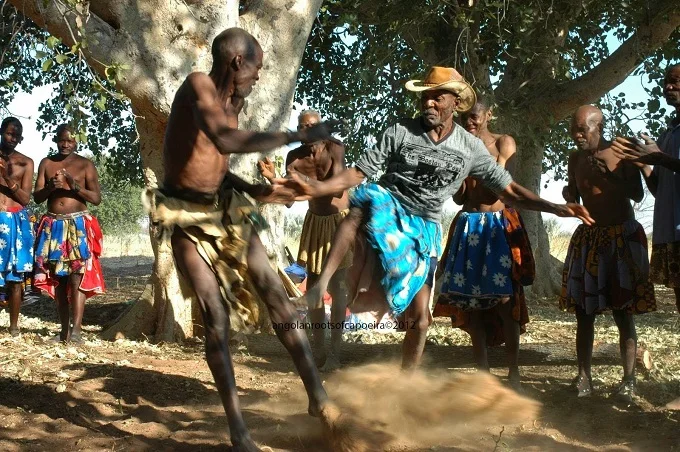
A martial dance that belongs to the martial arts. It is believed that this technique of performance and plastic movements, having come to Brazil, was transformed into the now world-famous Afro-Brazilian martial art capoeira. “Zebra dance” – as “ngolo” – is performed by young men proving their fighting spirit, strength, and self-confidence. It is common among the people of Angola and Mozambique.
2. Zaouli dance
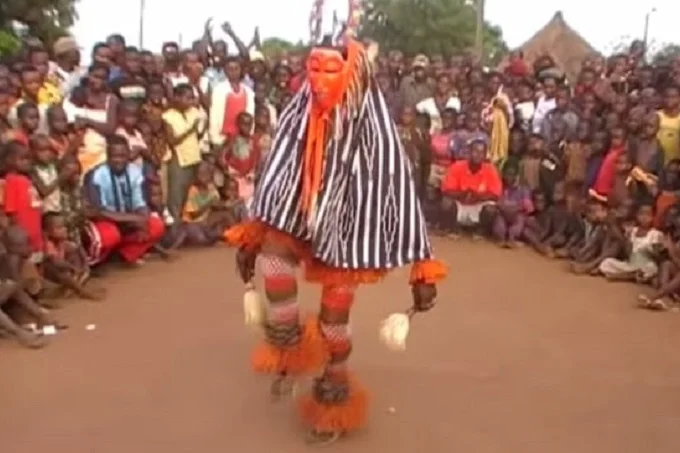
This spectacular dance was formed in the middle of the last century and became known thanks to the first president of Cote d’Ivoire, Felix Houphouët-Boigny, a great lover of the art of dance. The local Gouro people dance the Zaouli necessarily in bright clothes, a massive mask called Djela, and jewelry on their feet. Everyone danced, and at the right moment appears Zaouli master, who, to the accompaniment of music and the delight of the audience unusually fast, makes rhythmic foot movements.
3. Maasai dancing
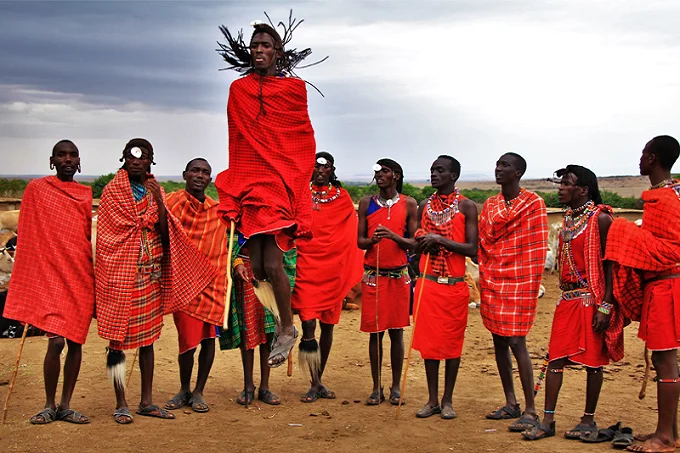
The Maasai people are some of the most famous representatives of the indigenous population of Africa, living on the savannah of Kenya and Tanzania. The slender, tall, proud Maasai are famous for their valor and skill as hunters and herders. They breed zebu, the charismatic African cows. They dress in bright, multi-colored cloaks, abundantly decorate themselves with bracelets, earrings, and beads made of beads. They live in houses made of branches and coated with a special mortar, which are quite good huts for semi-nomads.
And of course, dancing their famous national dance, the indispensable attribute of which is a stick. And no drums! The rhythm is set by stomping and throaty sounds. “Leaping dance is performed only by men (women sing at this time and watching, choosing a partner, or dance in their circle): they jump as high and level as possible, trying not to touch the ground with heels. The beginning of the jump, direction, and orientation of the body in space provides a stick in the hands of a jumper – he touches the ground with it – and soars up—a fascinating spectacle.
4. Zulu dance
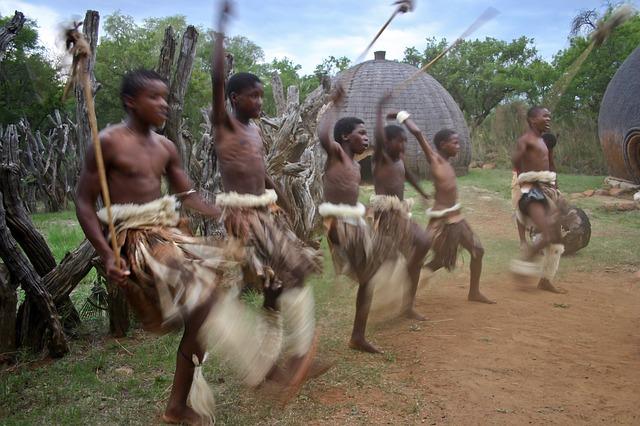
Traditional dances of the warriors of the Zulu tribe in today’s Zululand. Literally, ‘Zulu’ (amaZulu) translates as ‘children of the sky’. The traditional Zulu costume has always been leather loincloths, aprons, and colorful ornaments on the calves and forearms. Today the conventional costume is used only in folklore ensembles. As with all African tribes and peoples, music and dance are the main means of expressing feelings and emotions. For Zulu music, rhythm and melody are essential, and the harmony is known as Isigubudu.
5. Mohobelo dance
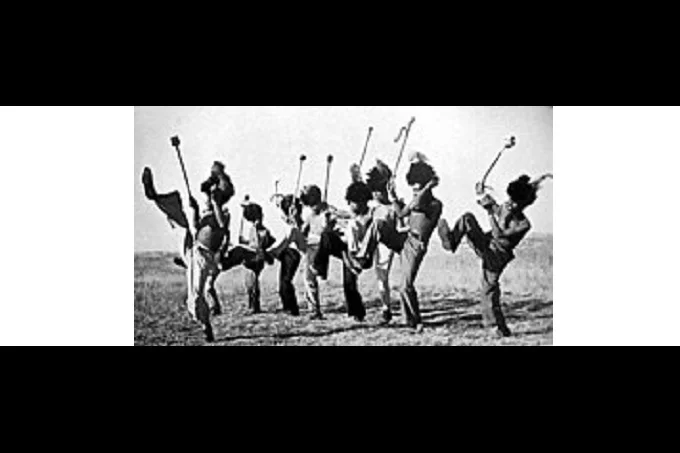
Basotho men have different kinds of traditional dance. One such dance movement is known as Mohobelo, in which only men or small boys participate. When the men dance Mohobelo, they step, slide, and stomp their feet, waving sticks from side to side and over their heads. During the rhythm of this dance, the Basotho men dance and sing together as a team in unison. Not only for a fun display, but this type of dance is of masculinity and an exercise in teamwork.
6. Muchongoyo and Jerusarema dance
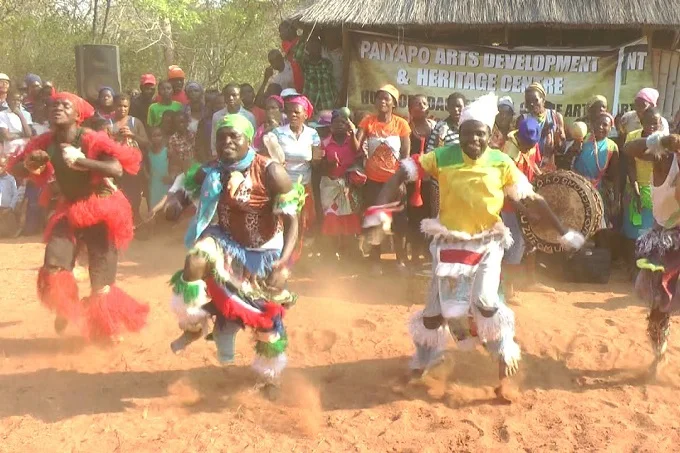
The Muchongoyo dance is in the age-old tradition. This dance is performed by tribal elders and is very strong in its spiritual traditions. Historically, the Muchongoyo dance was performed by men in preparation for war or after war, especially when Ndebele warriors won victories.
Mbende/Jerusalem dances are a popular style of dance practiced by the Zezuru Shona people living in eastern Zimbabwe, especially in the Murewa and Uzumba-Maramba-Pfungwe regions. It is intended for special occasions, usually religious, and is used to express people’s feelings. In addition, Mbende/Jerusarema was outlawed by Christian missionaries during the colonial period because of the provocative nature of the movements that characterize this dance style. This is because the performing dancers are often dressed in festive or wedding dress, even while performing ritual dances representing cattle and agriculture.
The Jerusalem and Muchongoyo dances are two of the most important, distinctive dances in Zimbabwe, and drums accompany both. Clans will compete for mujeks (prizes) in the form of docks, which will be tied at the top of a tree for every spectator to see.
7. Umteyo dance
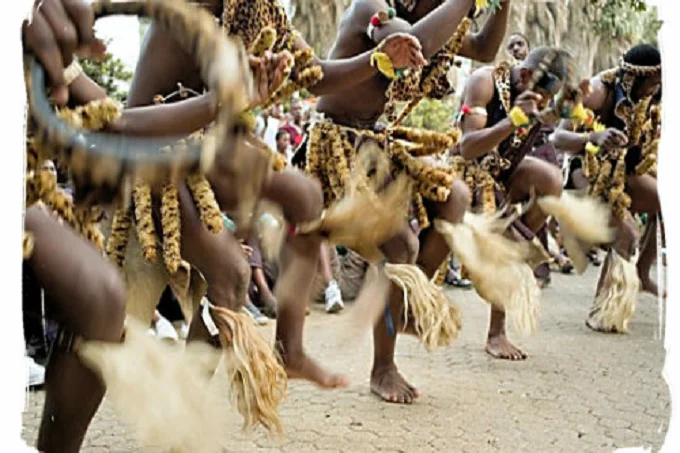
Umteyo tribal dance is the Xhosa dance, performed by young men, in which the whole torso is rapidly jiggling. Umteyo (Shake Dance) involves the rapid swaying or shaking of the ribcage so that it seems to ripple along the entire length of the spine. Older men, Amadoda, a so similar dance, Xhensa, accompanied by singing and clapping, while the dancers inhale and exhale through the relaxed larynx, emitting a kind of guttural roar.
8. Agahu or Gahu dance

The Egun-speaking Ketonu people, in what is now Benin, created the Agahu dance. Although the dance was thought to be based on the Yoruba dance of Badagry because a Yoruba costume was used, some Yoruba words were used in Agahu songs, and the dance is associated with the Nigerian city of Badagry. Agahu is one of the popular social dances in West Africa, and music is also very important to the dance.
The dance movements are closely related to percussion rhythms and songs. The leading drum, called the Agboba, a large barrel drum, can distinguish Agahu from other dances. There are two circles in this dance, one with men and one with women. In the Agahu dance, two circles are formed; the men remain motionless with their arms outstretched and then bend their knees forward to allow the women to sit down. They advance in a circle until they arrive with their original partner
9. Kpanlogo dance

Kpanlogo originates from Ghana, or more precisely, from the Ga ethnic group. This dance began in the capital, Accra, but is now enjoyed throughout the country. Kpanlogo is known as a form of high-life dance, performed to conga-like drums. Kpanlogo’s music is significant.
There is free movement in this dance, with arms waving. There is no silence in this dance; free-flowing movement, movement beginning or ending fills the pauses. The torso acts as the support base of this dance, as the center of gravity moves quickly from one foot to the other.
10. Agbekor dance
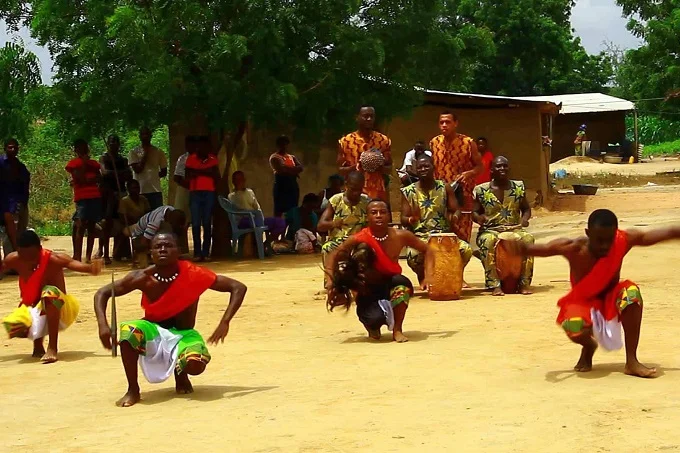
Agbekor, an African tribal dance, is one example of African warrior dance originating from the Foh and Ewe people. It is in the form of Atamga, one of the ancient dances. Agbekor is often performed at cultural events and funerals. The dance movements mimic combat tactics, such as striking with the end of a horsetail. This dance consists of phrases of steps. The expression consists of a ‘pivot’ that occurs in each phase, followed by another concluding movement.
11. Moribayassa dance
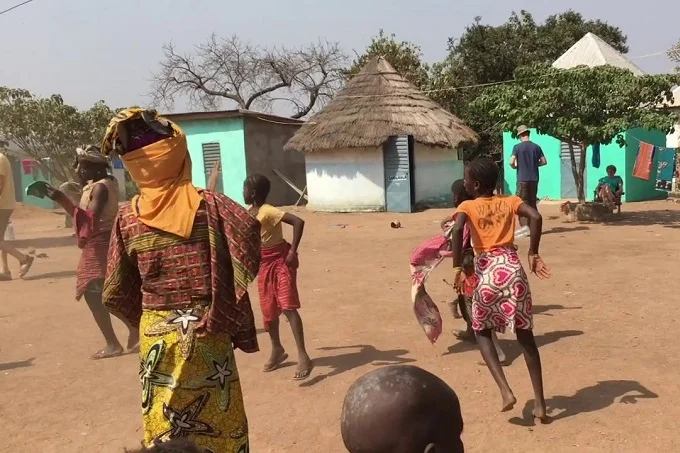
Moribayassa is an ancient dance performed when a woman comes out of a difficult ordeal in her life (in principle, she can only dance Moribayassa once in her life). For this dance, the woman dresses strangely (old clothes) and goes around the village with the musicians and the other women of the town. At the end of the dance, the woman changes and buries her clothes under a tree that bears the name of Moribayassa. This solo dance originated from the Malinke people of Guinea, and their women often say: “if my wish is granted, I will go and dance the Moribayassa”.
12. Yankadi dance

Yankadi is one of the traditional Sousou dances well known and often used by artists to touch the sensitivity of lovers better. Like all the other traditional rhythms of Guinea, the Yankadi dance obeys specific song and dance techniques. It is often associated with Makourou, another style of dance with a faster pace. Understand that the Yankadi has a slow and emotional rhythm. It is a dance of seducers.
Yankadi is slow and soft, while Makourou has a faster tempo with lots of movement. The men and women participating in the dance stand in rows facing each other; each has a scarf, and the dancers put their scarf on the one they want to dance with.
13. Assiko dance

Assiko, which comes from two Bassa words “Issi” and “koo” which signify the earth and the foot, embodies an ancient rhythm among the Bassa of Cameroon. However, contrary to popular belief, this is not an ancestral cultural heritage. In the oral tradition of these people, there are several accounts of the birth of Assiko. One of the most famous of these legends says that the arrival of the Spaniards in Cameroon (in Douala) gave birth to this rhythm. Assiko is then initiated when, by chance, an indigenous Bassa from the city of Douala, who was trying to play a few notes on the guitar of a Spanish administrator, succeeded in combining the sound of the said guitar with that of traditional percussions.
Another legend says that the Assiko was born in Bidjocka, not far from Eseka between Edéa and Otélé. The Canton chief Ndogbessol Bidjocka, who had been exiled to Sangmélima by the Germans, is rehabilitated on the arrival of the French. During the festivities organized in 1938 in honor of his return, an indigenous Baladin (public entertainer) plays the guitar to the rhythm of cries, drums, and balafons, which thus marks the birth of Assiko.
14. Bikutsi dance
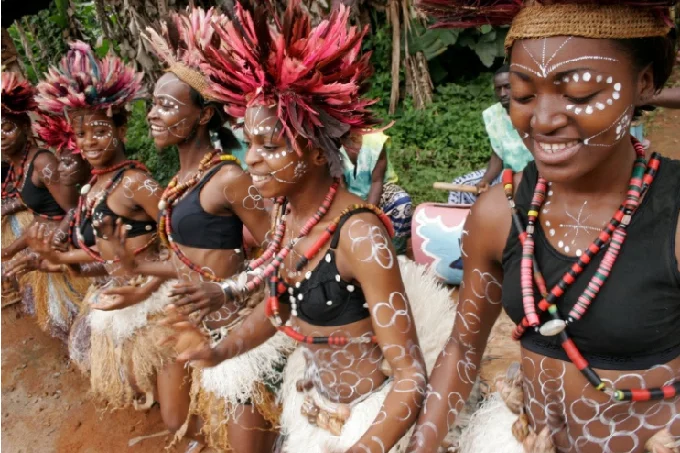
The Bikutsi is a dance traditionally practiced in Cameroon. Betis women mainly perform this dance. Intended to heal ailments, ease the pain of the loss of a loved one, and alleviate suffering, this dance is performed by the women seated on tiny stools. They sing and strike small rattles or bamboos folded in half along the length.
15. Mangambeu dance
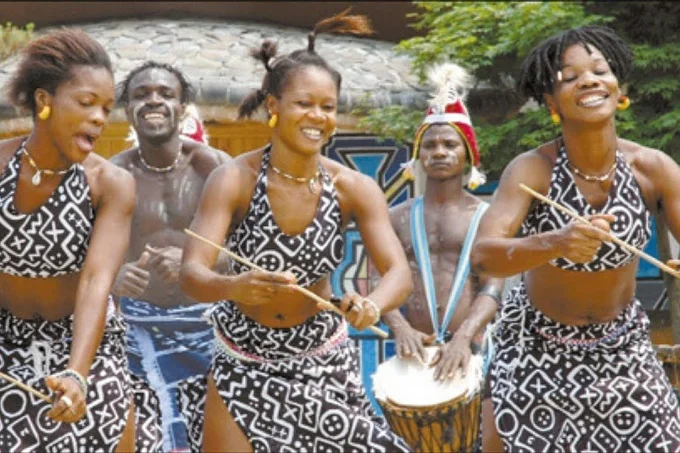
The Mangambeu is a dance and traditional music Bamileke of Cameroon, from among Bangangtés. The Mangambeu practitioners, men, and women, dance in circles with small steps; they sway and sometimes lean their torso forward. The music which accompanies them is played on xylophones and percussions mainly by men. This dance was born on the occasion of the wake of the notable Mafeu Biatat. The young girl of Moussa Tontchap splashed with her talent as a dancer particularly attracted the public’s attention and, from her name, was born the Mangambeu. The Mangambeu is used to enliven various ceremonies and festive occasions, such as birth ceremonies or weddings.
16. Menang and Oku dance
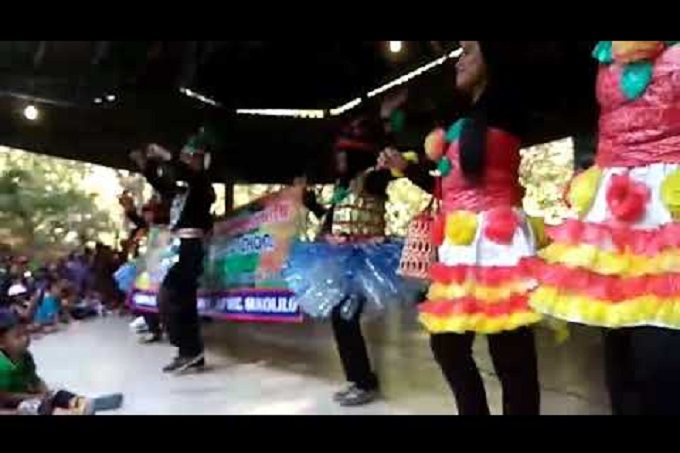
The Menang and the Oku are traditional dances of the Tikar people that have a mystical character and are only performed by one family. These are mainly women’s dances, but men take part in them. A particular rite is attached to this dancing tradition: Before starting the Menang and the Oku, a banana shoot is planted in the ground, growing flowers and producing fruits. Then, eventually, several families get together, and one of them is chosen to receive the right to practice these sacred dances. These two dances together are also used for special occasions such as funerals and weddings.
17. Ekitaguriro dance
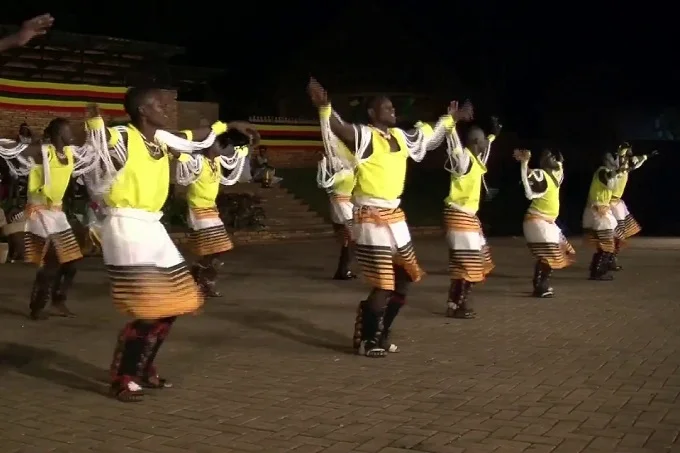
This is a dance performed by Banyankore. Banyankore comes from the land of Ankole, located in the western part of Uganda. It comes from the kingdom of Nkor or Ankole, which is one of the oldest traditional dynasties in Uganda. The Ekitaguriro is a dance performed by both men and women. They use it to tell stories, pass on important cultural information, good harvests, and celebrate fundamental life changes such as birth and marriage, but mostly to show appreciation for their cows.
The men step from foot to foot, mimicking the forward and backward movement that cows do when walking, while the women spread their arms across and over their heads in the image of long-horned cattle and sway majestically from side to side in unison. The dance is performed in the traditional Banyankor dance garb known as “bitambi” or “lessu” (wrapper), which is tightly tied around the waist and other lighter fabric around the shoulders, complete with a few African-themed decorations for the women. The men add shackle-like beads to their ensemble, whose main role is to draw attention to the movements of their feet and to complement the sounds of the Kitaguriro dance.
18. Larakaraka dance

Larakaraka dance is also known as the “courtship dance”. In pre-colonial Acholi, young men were allowed to demonstrate their dancing skills in an attempt to find a partner for marriage. This dance is still performed at traditional weddings to carry the torch according to the old custom.
The men appear on rooster feathers around their heads and carry calabashes, which they shake and pat rhythmically with small bags. The women mostly use their lower body, often swaying their hips and waist frantically to demonstrate femininity. The most common Acholi dance is Larakara.
19. Nankasa, Baakisiimba, Muwogola dance
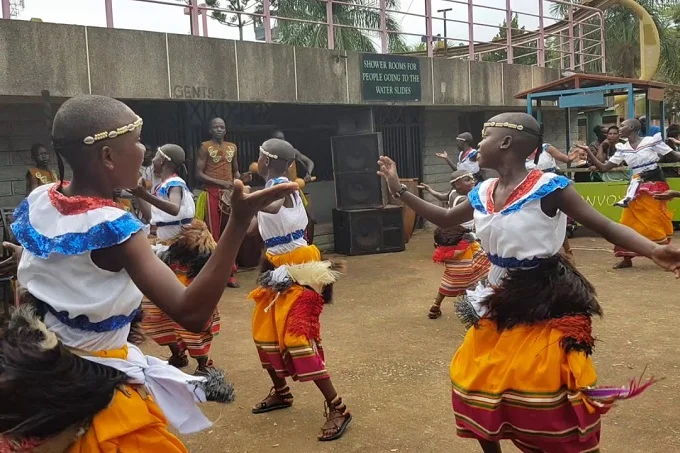
Nankasa, Baakisiimba, Muwogola dance is a traditional folk dance that originated in the kingdom of Buganda. Buganda consists of the Baganda people in the Central region of Uganda. In fact, a rather interesting story, the dance resulted from one kabaka from Buganda kingdom getting ‘drunk’ from the local drink ‘tonto’ or ‘omwenge’ made from bananas. As he danced with happiness, the people around him joined in, and it has been a festive dance among the Baganda people ever since.
20. Edonga dance

It is a dance performed by the Karamajong people who live in northeastern Uganda’s Kotido and Moroto districts. They are agropastoralists living mostly in steep hilly, and mountainous areas. The Edong dance is performed by leaping with all the weight of the body as high as one can to express enthusiasm and love for their culture and country.
21. Mbaga dance

The Baganda tribe traditionally practices Mbaga dance is Mbaga dance. It is usually performed by a woman who has reached 18 and is preparing for a future marriage. This dance expresses themes about being a good wife, giving birth and taking care of children, managing a home, and the like. They use instruments such as the tubular violin (Endigidi), drum (Namunjoloba), shakers (Ensaasi), and long drum (Engalabi).
22. Ekizino dance

It is a traditional dance of the Bakiga people of southwestern Uganda, known as the Kigezi. They are known for being tirelessly industrious farmers, able to work from morning till night. To commemorate their hard work and harvest, they perform the EKizino dance, consisting of clapping, Embuutu (big drum), Endere (flute), Ensaasi (shakers), and rhythmic singing led by a soloist. Both men and women jump and pound the ground, raising their arms up and down to match their feet. There is so much energy vibrating from the dancers to the ground in this dance and shouts of excitement complementing the singing.
23. Afro-jazz dance

Modern experimental dance afro-jazz as a movement appeared relatively recently – at the turn of XX and XXI centuries. The main rule – the absence of rules, the absolute freedom of movement, the most expressive transfer of emotions. Drum rhythm, jumps, rotations, free, not restricting movements, and absence of shoes. Jazz performance of folk dances, brought from the African continent, is evolving, merging with other styles and trends, steadily dominating among the current dance performances and theatrical actions.


